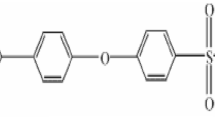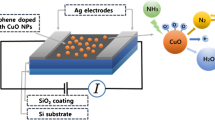Abstract
A highly efficient gas sensor is described based on the use of a nanocomposite fabricated from poly(3,4-ethylenedioxythiophene)-poly(styrenesulfonate) (PEDOT-PSS) and ultra-large graphene oxide (UL-GO). The nanocomposite was placed by drop casting in high uniformity on interdigitated gold electrodes over a large area of silicon substrate and investigated for its response to volatile organic compounds (VOCs) at room temperature. Monolayers of UL-GOs were synthesized based on a novel solution-phase method involving pre-exfoliation of graphite flakes. The nanocomposite was optimized in terms of composition, and the resulting vapor sensor (containing 0.04 wt% of UL-GO) exhibits strong response to various VOC vapors. The improved gas-sensing performance is attributed to several effects, viz. (a) an enhanced transport of charge carriers, probably a result of the weakening of columbic attraction between PEDOT and PSS by the functional groups on the UL-GO sheets; (b) the increase in the specific surface area on adding UL-GO sheets; and (c) enhanced interactions between the sensing film and VOC molecules via the network of π-electrons. The sensitivity, response and recovery times of the PEDOT-PSS/UL-GO nanocomposite gas sensor with 0.04 wt% of UL-GO are 11.3 %, 3.2 s, and 16 s, respectively. At a methanol vapor concentration as low as 35 ppm, this is an improvement by factors of 110, 10, and 6 respectively, compared to a PEDOT-PSS reference gas sensor without UL-GO.

PEDOT-based sensors for VOCs are presented that exhibit better sensivity, and shorter response and recovery times to methanol than previously known sensors







Similar content being viewed by others
References
Srivastava P, Pandit G, Sharma S, Rao AM (2000) Volatile organic compounds in indoor environments in Mumbai, India. Sci Total Environ 255(1):161–168
Wang L, Chen W, Xu D, Shim BS, Zhu Y, Sun F, Liu L, Peng C, Jin Z, Xu C (2009) Simple, rapid, sensitive, and versatile SWNT− paper sensor for environmental toxin detection competitive with ELISA. Nano Lett 9(12):4147–4152
Arasaradnam RP, Quraishi N, Kyrou I, Nwokolo CU, Joseph M, Kumar S, Bardhan KD, Covington JA (2011) Insights into‘fermentonomics’: evaluation of volatile organic compounds (VOCs) in human disease using an electronic‘e-nose’. J Med Eng Technol 35(2):87–91
Casalinuovo IA, Di Pierro D, Coletta M, Di Francesco P (2006) Application of electronic noses for disease diagnosis and food spoilage detection. Sensors 6(11):1428–1439
Peris M, Escuder-Gilabert L (2009) A 21st century technique for food control: electronic noses. Anal Chim Acta 638(1):1–15
Tung TT, Castro M, Kim TY, Suh KS, Feller J-F (2012) Graphene quantum resistive sensing skin for the detection of alteration biomarkers. J Mater Chem 22(40):21754–21766
Nardes AM, Kemerink M, De Kok M, Vinken E, Maturova K, Janssen R (2008) Conductivity, work function, and environmental stability of PEDOT: PSS thin films treated with sorbitol. Org Electron 9(5):727–734
Wu X, Li F, Wu W, Guo T (2014) Flexible organic light emitting diodes based on double-layered graphene/PEDOT: PSS conductive film formed by spray-coating. Vacuum 101:53–56
Frank I, Tanenbaum DM, Van der Zande A, McEuen PL (2007) Mechanical properties of suspended graphene sheets. J Vac Sci Technol B 25(6):2558–2561
Balandin AA, Ghosh S, Bao W, Calizo I, Teweldebrhan D, Miao F, Lau CN (2008) Superior thermal conductivity of single-layer graphene. Nano Lett 8(3):902–907
Cheng Z, Li Q, Li Z, Zhou Q, Fang Y (2010) Suspended graphene sensors with improved signal and reduced noise. Nano Lett 10(5):1864–1868
Robinson JT, Perkins FK, Snow ES, Wei Z, Sheehan PE (2008) Reduced graphene oxide molecular sensors. Nano Lett 8(10):3137–3140
Dan Y, Lu Y, Kybert NJ, Luo Z, Johnson AC (2009) Intrinsic response of graphene vapor sensors. Nano Lett 9(4):1472–1475
Kong J, Franklin NR, Zhou C, Chapline MG, Peng S, Cho K, Dai H (2000) Nanotube molecular wires as chemical sensors. Science 287(5453):622–625
Chang H, Lee JD, Lee SM, Lee YH (2001) Adsorption of NH 3 and NO 2 molecules on carbon nanotubes. Appl Phys Lett 79(23):3863–3865
Fowler JD, Allen MJ, Tung VC, Yang Y, Kaner RB, Weiller BH (2009) Practical chemical sensors from chemically derived graphene. ACS Nano 3(2):301–306
Ghosh A, Late DJ, Panchakarla L, Govindaraj A, Rao C (2009) NO2 and humidity sensing characteristics of few-layer graphenes. J Exp Nanosci 4(4):313–322
Cai W, Piner RD, Stadermann FJ, Park S, Shaibat MA, Ishii Y, Yang D, Velamakanni A, An SJ, Stoller M (2008) Synthesis and solid-state NMR structural characterization of 13C-labeled graphite oxide. Science 321(5897):1815–1817
Lerf A, He H, Forster M, Klinowski J (1998) Structure of graphite oxide revisited. J Phys Chem B 102(23):4477–4482
Tung TT, Kim TY, Shim JP, Yang WS, Kim H, Suh KS (2011) Poly (ionic liquid)-stabilized graphene sheets and their hybrid with poly (3, 4-ethylenedioxythiophene). Org Electron 12(12):2215–2224
Dan Y, Cao Y, Mallouk TE, Evoy S, Johnson AC (2009) Gas sensing properties of single conducting polymer nanowires and the effect of temperature. Nanotechnology 20(43):434014
Choi J, Lee J, Choi J, Jung D, Shim SE (2010) Electrospun PEDOT: PSS/PVP nanofibers as the chemiresistor in chemical vapour sensing. Synth Met 160(13):1415–1421
Dehsari HS, Shalamzari EK, Gavgani JN, Taromi FA, Ghanbary S (2014) Efficient preparation of ultralarge graphene oxide using a PEDOT: PSS/GO composite layer as hole transport layer in polymer-based optoelectronic devices. RSC Adv 4(98):55067–55076
Aboutalebi SH, Gudarzi MM, Zheng QB, Kim JK (2011) Spontaneous formation of liquid crystals in ultralarge graphene oxide dispersions. Adv Funct Mater 21(15):2978–2988
Gavgani JN, Adelnia H, Gudarzi MM (2014) Intumescent flame retardant polyurethane/reduced graphene oxide composites with improved mechanical, thermal, and barrier properties. J Mater Sci 49(1):243–254
Zhou N, Meng N, Ma Y, Liao X, Zhang J, Li L, Shen J (2009) Evaluation of antithrombogenic and antibacterial activities of a graphite oxide/heparin–benzalkonium chloride composite. Carbon 47(5):1343–1350
Wu X, Liu J, Wu D, Zhao Y, Shi X, Wang J, Huang S, He G (2014) Highly conductive and uniform graphene oxide modified PEDOT: PSS electrodes for ITO-Free organic light emitting diodes. J Mater Chem C 2(20):4044–4050
Yoon H, Chang M, Jang J (2007) Formation of 1D poly (3, 4‐ethylenedioxythiophene) nanomaterials in reverse microemulsions and their application to chemical sensors. Adv Funct Mater 17(3):431–436
Wang X, Sun X, Hu PA, Zhang J, Wang L, Feng W, Lei S, Yang B, Cao W (2013) Colorimetric sensor based on self‐assembled Polydiacetylene/graphene‐stacked composite film for vapor‐phase volatile organic compounds. Adv Funct Mater 23(48):6044–6050
Feller J-F, Lu J, Zhang K, Kumar B, Castro M, Gatt N, Choi H (2011) Novel architecture of carbon nanotube decorated poly (methyl methacrylate) microbead vapour sensors assembled by spray layer by layer. J Mater Chem 21(12):4142–4149
Dan Y, Cao Y, Mallouk TE, Johnson AT, Evoy S (2007) Dielectrophoretically assembled polymer nanowires for gas sensing. Sensors Actuators B Chem 125(1):55–59
Kumar B, Feller J-F, Castro M, Lu J (2010) Conductive bio-polymer nano-composites (CPC): chitosan-carbon nanotube transducers assembled via spray layer-by-layer for volatile organic compound sensing. Talanta 81(3):908–915
Tung TT, Castro M, Feller J-F, Kim TY, Suh KS (2013) Hybrid film of chemically modified graphene and vapor-phase-polymerized PEDOT for electronic nose applications. Org Electron 14(11):2789–2794
Tung TT, Castro M, Kim TY, Suh KS, Feller J-F (2014) High stability silver nanoparticles–graphene/poly (ionic liquid)-based chemoresistive sensors for volatile organic compounds’ detection. Anal Bioanal Chem 406(16):3995–4004
Tung TT, Castro M, Pillin I, Kim TY, Suh KS, Feller J-F (2014) Graphene–Fe 3 O 4/PIL–PEDOT for the design of sensitive and stable quantum chemo-resistive VOC sensors. Carbon 74:104–112
Suchea M, Katsarakis N, Christoulakis S, Nikolopoulou S, Kiriakidis G (2006) Low temperature indium oxide gas sensors. Sensors Actuators B Chem 118(1):135–141
Choi KS, Liu F, Choi JS, Seo TS (2010) Fabrication of free-standing multilayered graphene and poly (3, 4-ethylenedioxythiophene) composite films with enhanced conductive and mechanical properties. Langmuir 26(15):12902–12908
Romero HE, Joshi P, Gupta AK, Gutierrez HR, Cole MW, Tadigadapa SA, Eklund PC (2009) Adsorption of ammonia on graphene. Nanotechnology 20(24):245501
Parmar M, Balamurugan C, Lee D-W (2013) PANI and graphene/PANI nanocomposite films—comparative toluene Gas sensing behavior. Sensors 13(12):16611–16624
Huang X, Hu N, Gao R, Yu Y, Wang Y, Yang Z, Kong ES-W, Wei H, Zhang Y (2012) Reduced graphene oxide–polyaniline hybrid: preparation, characterization and its applications for ammonia gas sensing. J Mater Chem 22(42):22488–22495
Author information
Authors and Affiliations
Corresponding author
Additional information
Amirhossein Hasani, Hamed Sharifi Dehsari and Jaber Nasrollah Gavgani contributed equally to this work.
Electronic supplementary material
Below is the link to the electronic supplementary material.
ESM 1
(DOCX 1157 kb)
Rights and permissions
About this article
Cite this article
Hasani, A., Dehsari, H.S., Gavgani, J.N. et al. Sensor for volatile organic compounds using an interdigitated gold electrode modified with a nanocomposite made from poly(3,4-ethylenedioxythiophene)-poly(styrenesulfonate) and ultra-large graphene oxide. Microchim Acta 182, 1551–1559 (2015). https://doi.org/10.1007/s00604-015-1487-7
Received:
Accepted:
Published:
Issue Date:
DOI: https://doi.org/10.1007/s00604-015-1487-7




